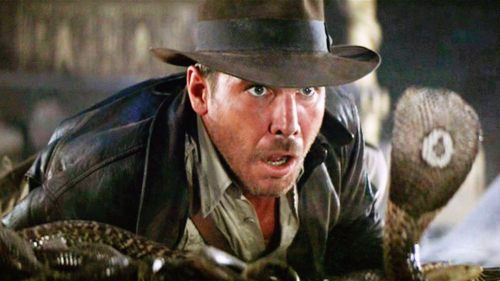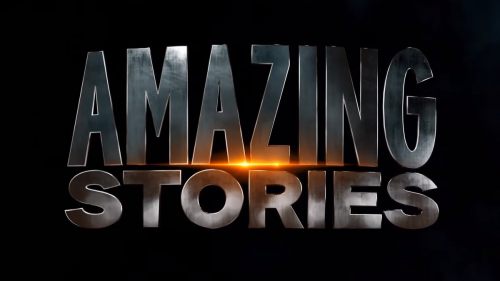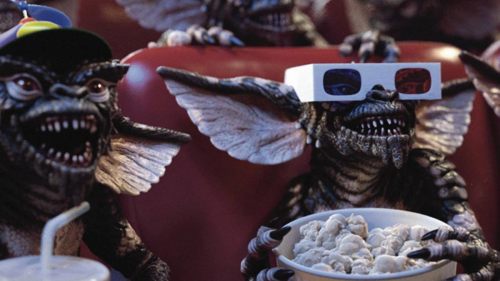SXSW Review: READY PLAYER ONE Is Spielberg’s Second Peter Pan Movie
It was the movie everybody said Steven Spielberg shouldn’t make: an adaptation of Ernie Cline’s nostalgia-laden bestselling fantasy, comprised of almost nothing but heaps upon heaps of movie, comic book, video game and ‘80s jukebox references that the author seemed to have kept a running Live Journal of while crafting his work of zippy beach prose. In the eyes of many, Ready Player One was beneath the great Beard; a waste of his considerable talents, especially since he’d just churned out one of the most vital and politically relevant movies of his career (last year’s The Post), plus the severely underrated Cold War spy thriller that reminded us of the true virtue of American decency (Bridge of Spies). As a book, RPO is rooted in iconography without seemingly understanding the meaning behind any of it; a fanboy’s silly wet dream, harnessed around the thinnest of plots and silliest of set pieces (a whole sequence set inside the Matthew Broderick movie WarGames? Yeesh).
Funny how informed opinions work, as after actually seeing Spielberg’s Ready Player One, it becomes readily apparent that nobody but our greatest American pop filmmaker could’ve even attempted to make this clunky bit of self-indulgence operate at the breathless level of consistency it does. Instead of Cline’s self-congratulatory words, we have Spielberg taking all these images and transmuting them into a free-flowing amalgamation of dorky fluff, filtered through the bleary-eyed blue/grey haze we’ve come to know and love from the director’s sci-fi collaborations with cinematographer Janusz Kaminski (Minority Report).
This is “Big Kid” cinema of the highest order from Spielberg: a silly, speeding, bombastic roller coaster ride that lets us blast Freddy Krueger with a laser, outrun a marauding King Kong, and traverse the endless corridors of the Overlook Hotel. Essentially, he’s playing in a sandbox he’s helped create and redefine with other New Hollywood legends and their successors for over fifty years, creating an elliptical visual dialogue where pop is in conversation with itself, speaking a dialect that may be too niche for its own good at times.
Ready Player One is Spielberg’s second Peter Pan movie (following 1991’s abysmal career low, Hook), where this digital Neverland allows all who exist in the film's bombed out, economically decrepit vision of the future to escape and live out their wildest wishes, never having to grow up for the fleeting moments they spend inside the OASIS. Introduced to us via the movie’s awkward opening voice over, Wade Owen Watts (Tye Sheridan) walks us through this immersive pixelated dreamscape, which is comprised of everything from gambling worlds, to full scale combat arenas on distant planets, where users wear whatever skin they want as an avatar. This is multiplayer Disneyland; a virtual reality nowheresville that’s addicting because your cares never stretch beyond completing the next level, all while “add-ons” such as full-body sensation suits are sold in the real world to help augment the experience.
It’s eXistenz for those who grew up playing Warcraft instead of watching David Cronenberg movies. Though Zak Penn and Cline’s script struggles to boil the wonky jargon of the novel down to a presentable information dump, Spielberg’s camera becomes untethered by the laws of gravity, zooming through imagined environment after imagined environment, barely slowing down from its breakneck pace for us to stop and marvel at this post-cinema mish-mash. It’s an interesting moment of creative discord, as you can practically feel the master outrunning the subpar material, looking back over his shoulder and hollering “c’mon you guys, keep up!” at his obvious idolaters.
The plot – so much as there is one – revolves around video game logic. The creator of the OASIS, James Donovan Halliday (Mark Rylance – playing the guru as a strange hybrid of Steve Jobs and Geddy Lee), has sadly passed away. In his departure, Halliday left one final challenge: to find three keys that will unlock an Easter Egg, bestowing the OASIS and a huge chunk of cash to whoever is able to complete this quest. Along with his buddies Aech (Lena Waithe), Art3mis (Olivia Cooke), Daito (Win Morisaki), and Sho (Philip Zhao), Watts (via his avatar Parzival) embarks on this epic adventure, hoping to keep the OASIS out of the hands of corporate fat cats – led by a sneering, oversized denture-sporting Ben Mendelsohn. The set up gives way to an eye-popping race, as we’re careening down tracks in Parzival’s DeLorean, hoping to keep it on the road and avoid crashing, respawning, and losing our digital currency. Because once those coins leak from your shattered online form, you’re starting from scratch, noob.
This is where the cognitive dissonance of Ready Player One may lose some: it’s a movie steeped in and sold off intellectual property imagery – which has been remixed and regurgitated in order to create this whole new attraction to get paying butts in seats. At the same time, it spins a narrative of the underclass rising up to reclaim these images as their own, before a massive corporate conglomerate can obtain, pirate, and bastardize it. In essence, we’ve bought a ticket to a rather spiffy laser light show that asks us to consider revolting against those who just sold us this seat. It’s either a brazen gag at the audience’s expense, or an utter lack of self-awareness on the creators’ parts, producing a studio tent-pole that’s a little too thematically mush-mouthed for anyone who’s going to stop and consider the movie for five minutes after the picture stops rolling. It’d be like Marvel making an Avengers movie where Mickey Mouse is the bad guy, holding our heroes captive in Space Mountain until vacationers execute the dastardly rodent and unshackle the icons.
However, the hyper-earnest “kid in a candy store” attitude makes you not a give a shit about any of that while the actual movie’s playing. Ready Player One is one of the most egregiously set piece driven slices of pop cinema we’ve seen in a long while, making us remember that this the same guy who gave us the gloriously escapist Temple of Doom (which in itself is really nothing more than a series of interconnected serial thrills made up of impressive miniature/stunt work).
Once we’re done outrunning Skull Island’s chief crusher, we’re entering the Overlook Hotel (in one of the movie’s loopiest, most awesome sequences), watching as these endeavoring gamers encounter the creepy twins and ride on waves of blood, all while seeking out the next hiding place for Halliday’s wizard avatar Anorak. Hot on their tails are goons hired by this oppressive business entity, including i-R0k (T.J. Miller), a sarcastic wisecracking Skeletor-looking motherfucker who seems like he’s always on a stand-up comedy stage. Ready Player One is fundamentally one long chase film, created with the same eye for insane animated aerobatics that made The Adventures of Tintin so immensely enjoyable.
Perhaps most intriguing – and possibly underexplored – are the movie’s themes regarding online identity, and how we use social media to engage others, while simultaneously shielding them from the worst parts of ourselves. These avatars are really nothing more than the idealized selves of everyone who’s playing, conjurings that cover up the flaws they’re embarrassed by, or even their entire gender (as we all could just be “a fat man from Detroit” once we’re logged in). Watching this movie at the SXSW film festival – which itself becomes a week-long playground for many who only know one another online, coming together in concert halls and movie theaters to escape from day jobs and children – is weirdly perfect, and highlighted the deeper core Ready Player One could’ve fiddled with just a touch more. Though he does so in a rather juvenile fashion, Cline’s still rather observant regarding the ways that Internet culture has permeated the mainstream, letting those of us who choose to lead double lives do so, and even thrive because of this dichotomy.
To be fair, for those who already made up their minds regarding Ready Player One based on either the text itself or the negative critical narrative that's already all but set in stone via Film Twitter and comments sections, there's probably little here that's going to sway them in the opposite direction. This is Spielberg at his very lightest, delivering a piece of populist entertainment that contains as many empty calories as the popcorn you munch in the auditorium while you watch it. He's not dissecting or interrogating the book in any real way, and for some this will simply not be enough. Yet the craft on display is impossible to deny, as is the acclaimed director's knack for constructing some of the most elbaorate escape set pieces in the history of the medium. For those simply looking for a healthy shot in the arm of whizz bang spectacle, Ready Player One will more than delight, as this is still an aging master filmmaker having as much fun as humanly possible while he still can.



